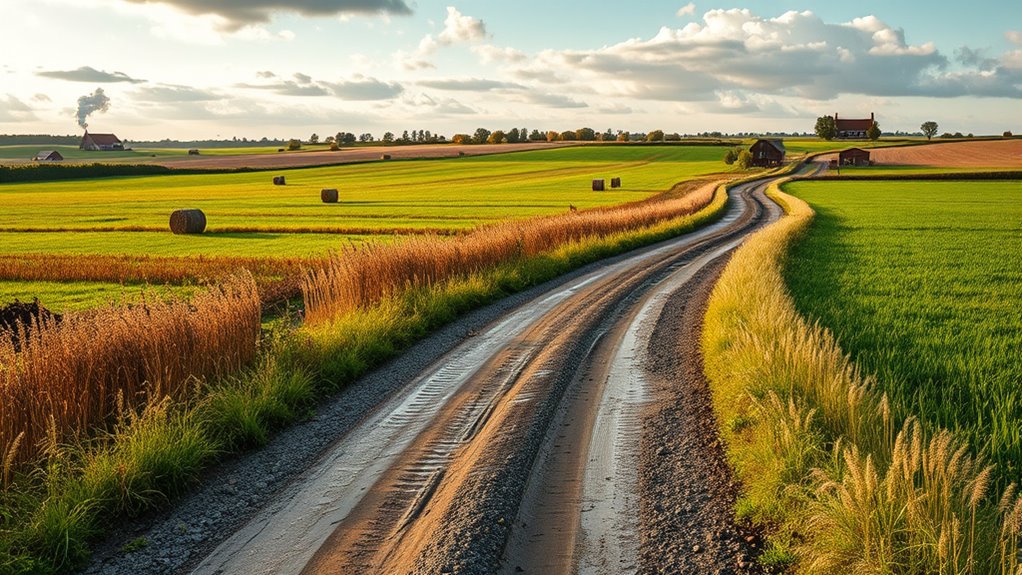To prepare your farm roads for autumn rains, start by inspecting their current condition, looking for potholes, soil compaction, or drainage issues. Stabilize and grade surfaces to guarantee proper slope and drainage pathways. Install or clear drainage features like culverts and ditches to prevent water pooling. Reinforce gravel surfaces and add erosion control measures such as vegetation. Regular maintenance and early repairs are key — stay tuned for more tips to keep your roads resilient.
Key Takeaways
- Conduct thorough inspections and address potholes or surface issues to ensure smooth, durable roads before heavy autumn rains.
- Implement proper drainage solutions like culverts, ditches, and grading to prevent water pooling and erosion.
- Stabilize gravel surfaces through leveling and compaction for better drainage and reduced washouts.
- Schedule regular maintenance and soil testing to monitor soil moisture, compaction, and potential trouble spots.
- Clear signage, debris, and vegetation to improve safety and ensure unobstructed water flow during wet weather.
Assessing the Current Condition of Your Farm Roads

Before the autumn rains arrive, it is vital to evaluate the current state of your farm roads. Start by inspecting the soil compaction levels, as heavily compacted soil can lead to poor drainage and ruts during wet weather. Use a soil penetrometer or simply test by pressing a metal rod into the ground; if it’s hard to penetrate, compaction is an issue. Next, check your signage placement. Confirm warning signs are visible and strategically positioned to alert drivers of potential hazards like soft spots or uneven surfaces. Clear, well-placed signage helps prevent accidents and guides drivers safely through your farm. Conduct a thorough walkover to identify trouble spots and note areas needing attention. Addressing soil compaction and signage placement now ensures your farm roads are better prepared for the autumn rains. Additionally, reviewing best maintenance practices for farm roads can help you implement long-term solutions to improve durability and drainage, which are critical for handling heavy rainfall. Regularly monitoring soil drainage and performing necessary repairs can further enhance your roads’ resilience against seasonal weather challenges. Incorporating strategic drainage improvements can significantly reduce water accumulation and erosion during heavy downpours.
Implementing Effective Drainage Solutions
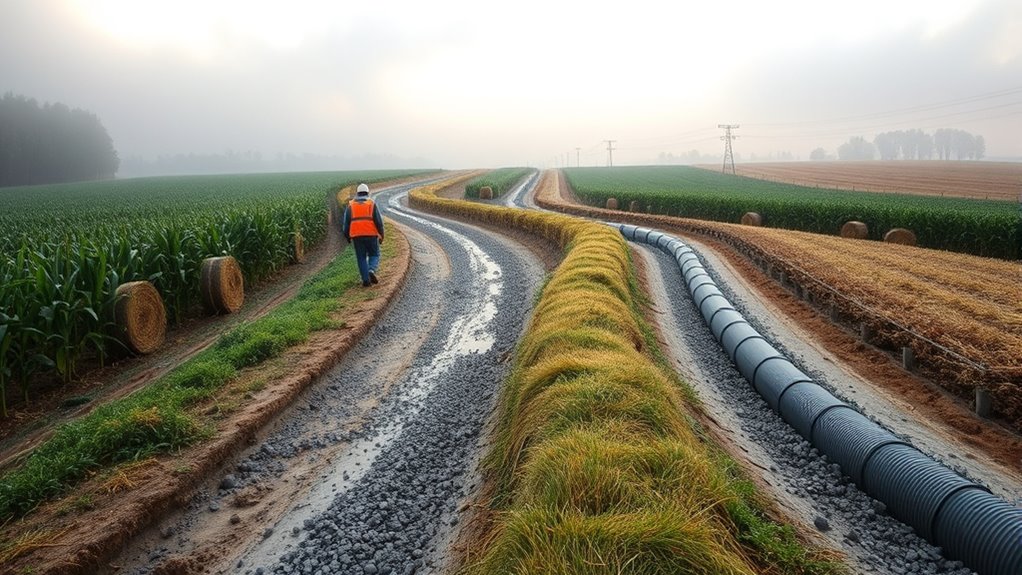
To guarantee your farm roads handle autumn rains effectively, you need to implement proper drainage solutions. Start with a good drainage system design that directs water away from the road surface and underlying soil. Proper grading ensures water flows naturally toward designated outlets, reducing erosion and puddling. Incorporate water runoff management strategies, such as installing ditches, culverts, or swales, to control excess water. Keep drainage channels clear of debris so water moves freely. Consider the slope and natural flow of your land when planning drainage features. Well-designed drainage minimizes water pooling, preserves road integrity, and prevents washouts during heavy rains. Additionally, selecting appropriate natural materials like stone or wood can enhance the durability of drainage structures. Using self-watering plant pots as an analogy, incorporating moisture control methods into your drainage plan can improve overall effectiveness. Proper land grading and contouring are essential for directing water flow efficiently and avoiding erosion issues. By focusing on effective water runoff management, you’ll maintain safe, durable farm roads throughout autumn, and integrating erosion prevention techniques can further safeguard your infrastructure.
Reinforcing and Grading Road Surfaces
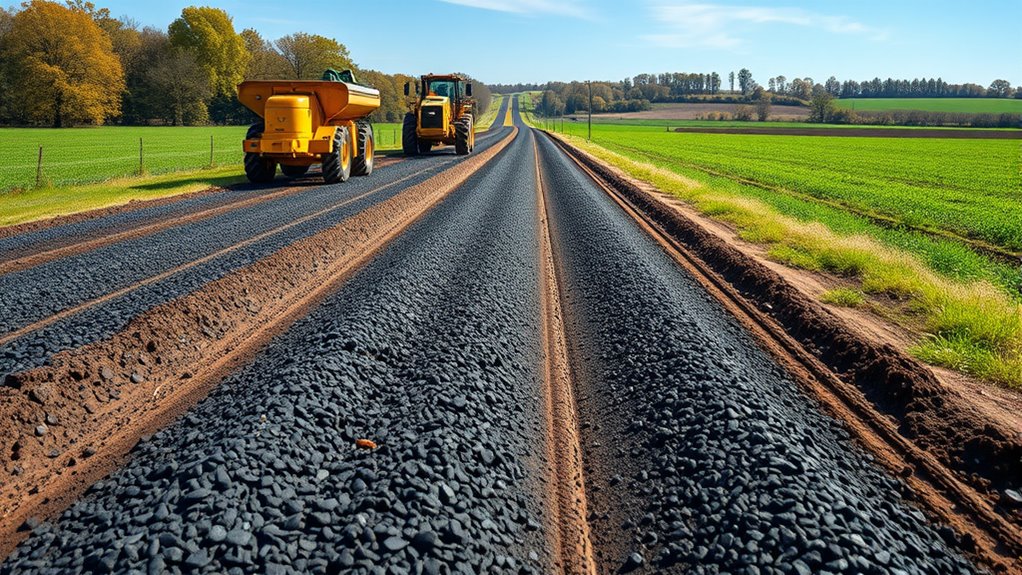
Reinforcing and grading your farm roads is essential for ensuring they can withstand heavy autumn rains. Start by inspecting the surface for potholes and fill them promptly with suitable repair materials to prevent further deterioration. Proper pothole repair keeps the road smooth and reduces water pooling. Next, focus on gravel stabilization by adding or leveling gravel to create a firm, well-draining surface. Use a grader to shape the road surface, ensuring proper slope for drainage and an even foundation. Compact the gravel thoroughly to prevent shifting and erosion during heavy rains. Regular grading maintains surface integrity, reduces mud and ruts, and extends the road’s lifespan. Incorporating proper surface preparation techniques and utilizing grading tools enhances the durability of your farm roads, ensuring they stay durable, safe, and functional throughout the rainy season. Additionally, applying techniques from AI in Education, such as data-driven assessments of road conditions, can help plan maintenance schedules more effectively. Implementing durable materials during repairs can further improve resilience to weather impacts.
Installing Erosion Control Measures
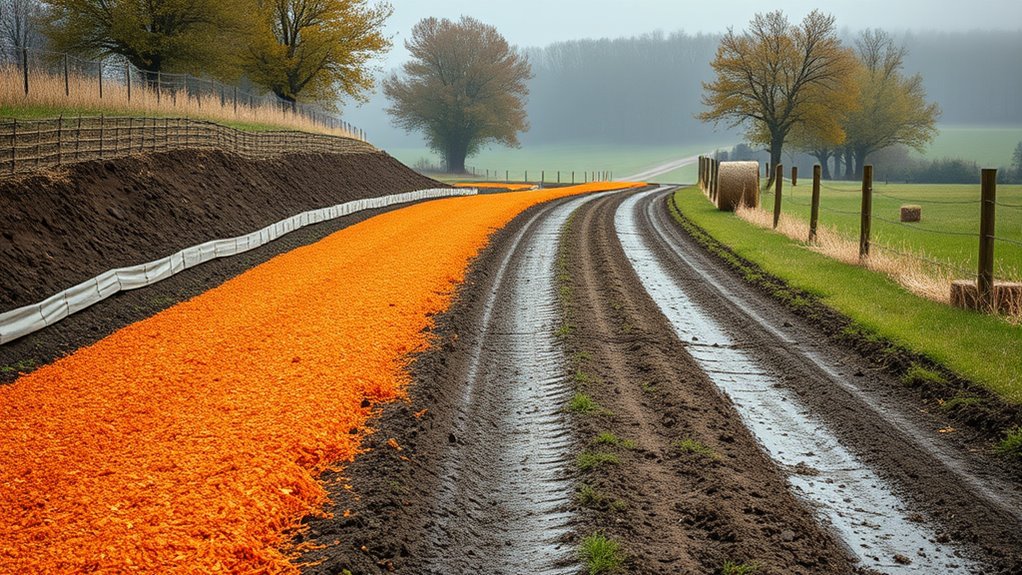
After leveling and compacting your gravel roads, installing erosion control measures becomes essential to protect the surface during heavy autumn rains. Proper vegetation management helps stabilize soil and reduces runoff. Use weed control to clear invasive plants that can weaken soil structure. Installing silt fences or erosion control mats at problem spots prevents washouts. Consider planting cover crops or grass along slopes to further hold soil in place. Regularly inspect these measures to ensure effectiveness. Incorporating sound healing science techniques, such as using specific frequencies, can also promote soil health and stability in your landscape. Additionally, integrating vetted erosion control products ensures long-term durability and effectiveness. Being aware of regional resources can help you select the most suitable solutions for your area. Utilizing evidence-based methods can further enhance erosion prevention efforts.
Developing a Maintenance and Monitoring Schedule
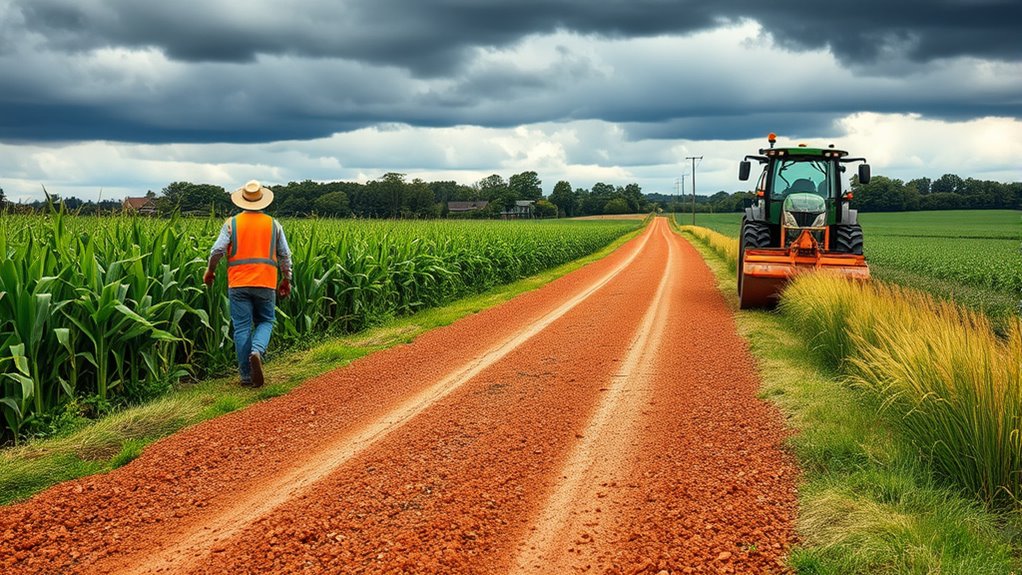
Establishing a regular maintenance and monitoring schedule is crucial for ensuring your farm roads remain resilient throughout autumn rains. You should routinely inspect for soil compaction, which can lead to poor drainage and increased erosion. Addressing compacted areas promptly by aerating or adding gravel to improve soil structure helps maintain proper water flow and prevents larger issues. Keep vegetation management in mind; maintaining clear, healthy vegetation along the roads prevents overgrowth that can obstruct drainage and weaken the roadbed. Schedule inspections after heavy rainfalls to identify any emerging issues early. Regular monitoring allows you to spot signs of deterioration and respond quickly, preventing costly repairs later. Being aware of symptoms of road deterioration, such as surface cracking or unusual pooling, helps in early intervention. Additionally, understanding sail boat storage ideas can inspire creative solutions for managing materials and equipment on your farm during rainy seasons. Incorporating data-driven strategies into your maintenance plan ensures that your efforts are targeted and effective. Employing soil testing techniques can further help identify underlying issues before they become serious. Implementing fraud detection techniques in your record-keeping can help prevent financial discrepancies related to maintenance expenses. By sticking to a consistent maintenance plan, you’ll ensure your farm roads stay functional, safe, and prepared for the challenges of autumn weather.
Frequently Asked Questions
What Are the Best Materials for Temporary Road Repairs Before Heavy Rains?
For temporary road repairs before heavy rains, you should focus on using gravel stabilization to improve soil strength and prevent erosion. Asphalt patching is also effective for quick fixes on potholes and cracks, providing a solid surface that resists water damage. Combining these materials guarantees your roads stay intact longer, giving you a reliable path through wet conditions. Make sure to compact the materials well for maximum durability.
How Can I Prevent Mudslides on Steep Farm Roads During Autumn Rains?
To prevent mudslides on steep farm roads during autumn rains, you should focus on effective drainage solutions and slope stabilization. Install proper drainage systems like culverts and ditches to direct water away from slopes. Use erosion control methods such as planting cover crops or installing retaining walls. Regularly inspect and maintain these solutions to guarantee they work efficiently. These steps help keep your roads safe and reduce the risk of mudslides during heavy rains.
Are There Eco-Friendly Options for Erosion Control on Farm Roads?
Imagine you’re using vegetation barriers and organic mulches to prevent erosion on your farm roads. In a real case, farmers planted native shrubs along slopes, creating natural barriers that slowed runoff. Organic mulches, like straw or wood chips, further protected soil. These eco-friendly options work together to stabilize the soil, reduce mudslides, and promote healthy land, all while being gentle on the environment.
How Often Should I Inspect My Farm Roads During the Rainy Season?
You should inspect your farm roads at least once a week during the rainy season to catch issues early. An effective inspection schedule helps identify erosion, washouts, or potholes before they worsen. Depending on weather conditions, increase inspection frequency after heavy rains. Regular checks allow you to perform timely maintenance, preventing costly repairs later. Staying vigilant guarantees your roads stay functional and safe, even during intense autumn rains.
What Signs Indicate That a Farm Road Needs Urgent Repair Before Rains?
Your farm road whispers warnings like a watchful guardian. Look for drainage issues that cause water to pool or flow improperly, signaling urgent repairs. Surface cracks spreading across the path act as fault lines, risking collapse when rains hit. If you notice these signs, act quickly. Address drainage problems and seal cracks now to prevent erosion and guarantee your road withstands the coming storms, safeguarding your fields and livelihood.
Conclusion
By taking these proactive steps, you can keep your farm roads in top shape through autumn rains. Regular maintenance and proper drainage can reduce erosion by up to 70%, saving you time and money in the long run. Remember, a well-prepared road not only guarantees safe travel but also protects your livelihood. Stay vigilant, monitor conditions frequently, and you’ll be ready to face the season’s challenges head-on. Your farm’s success depends on it.

